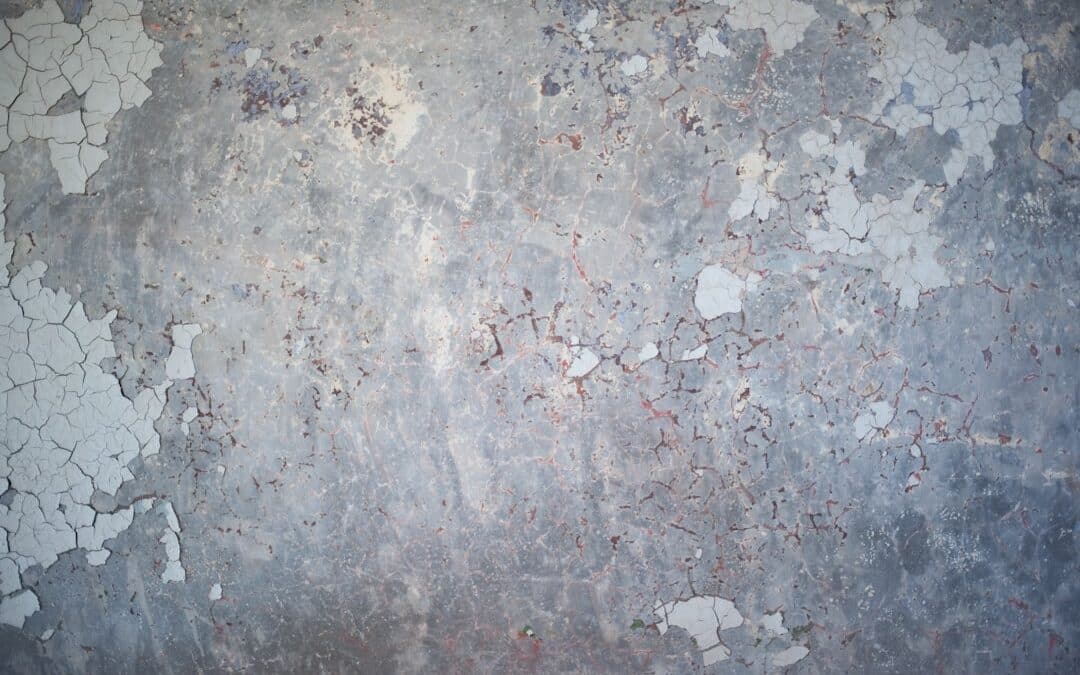Finding the Best Basement Concrete Floor Paint
When renovating, many homeowners overlook the basement floor, yet it endures significant moisture, foot traffic, and spills. Choosing the best basement concrete floor paint is key to changing this critical space.
For a quick answer, here are top choices based on common needs:
- Overall Durability & Longevity: Epoxy coatings (e.g., Rust-Oleum EpoxyShield) offer superior resistance to wear, chemicals, and moisture, lasting 10-20 years.
- Best DIY & Value: DRYLOK Latex Concrete Floor Paint is a popular, self-priming option known for its ease of use and good coverage.
- Strong Acrylic Option: INSL-X Tough Shield Acrylic Floor/Patio Coating provides high coverage and solid performance for those preferring an acrylic.
Painting your basement floor adds durability and protects the concrete. This guide will walk you through everything you need to know.
I’m Darin Garvey. For over 30 years, my team at Basement Waterproofing Scientists has helped homeowners achieve dry, usable basements. This experience, which often involves selecting and applying the best basement concrete floor paint, has given us unique insights into what truly works.
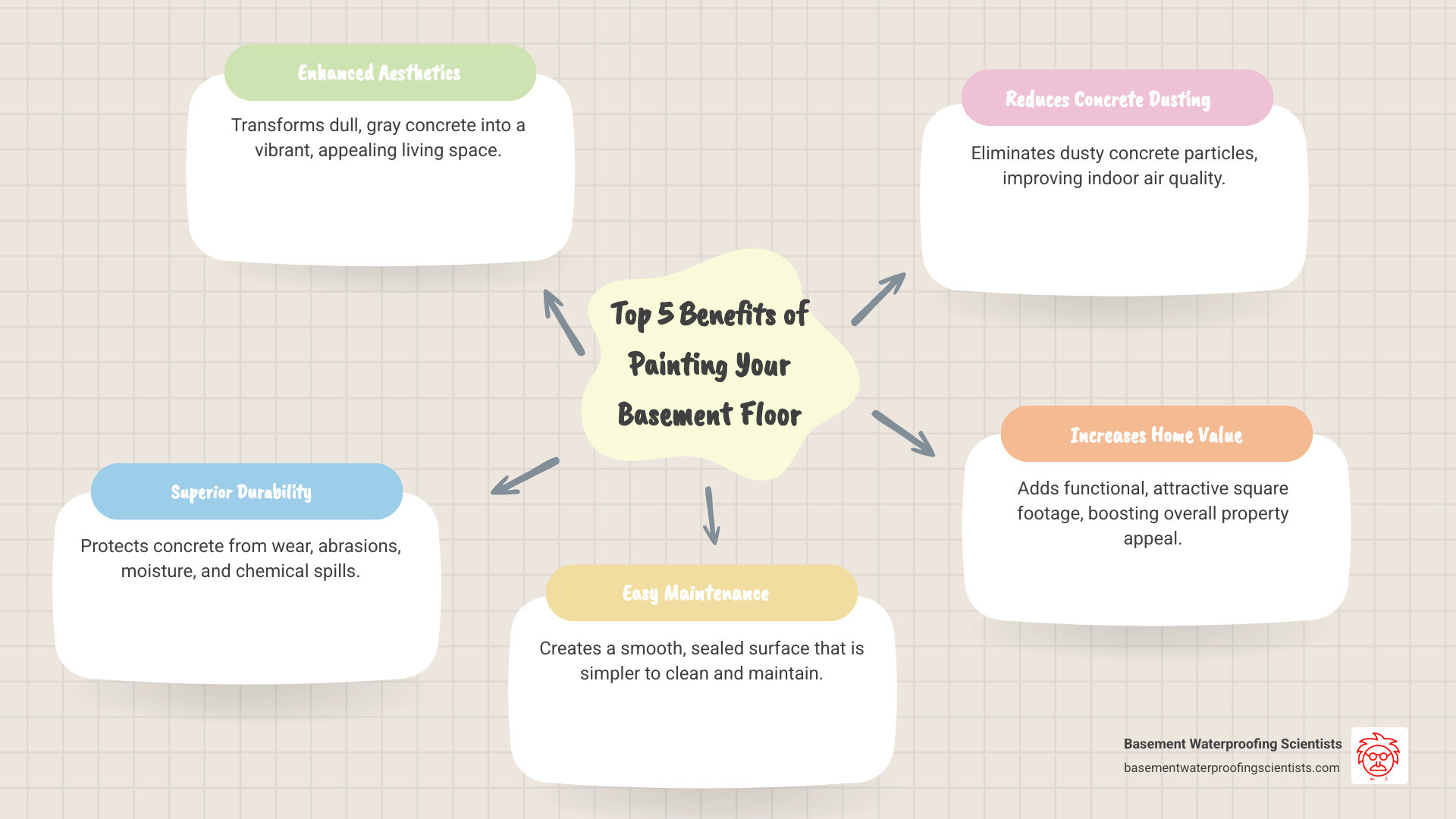
Quick best basement concrete floor paint terms:
Why Paint Your Basement Concrete Floor? More Than Just a Pretty Surface
Bare, gray concrete is functional but uninspiring. Choosing the best basement concrete floor paint is a smart investment that solves several practical problems while dramatically improving the look of the space.
Aesthetics: A painted floor instantly brightens a typically dreary space. It replaces an industrial, unfinished look with a clean, polished surface that makes the basement more inviting.
Durability: Quality concrete paint creates a protective shield, making the floor more resilient to daily wear and tear, scuffs, and impacts. It’s like armor for your concrete.
Longevity: A well-painted concrete floor can last for many years. Epoxy coatings can protect a floor for 10 to 20 years, while even budget-friendly options provide several years of protection.
Reduces Dusting: Unfinished concrete constantly sheds fine, powdery residue. Paint seals the surface completely, eliminating this dusty nuisance.
Easier Cleaning: A smooth, painted surface is far easier to sweep, vacuum, and mop than porous concrete. Spills wipe up easily instead of soaking in.
Radon Reduction: While not a primary mitigation strategy, a properly sealed and painted floor can help reduce radon gas entry by creating an additional barrier.
Increases Home Value: A finished basement with a quality painted floor adds functional, attractive square footage, which is an improvement that pays you back.
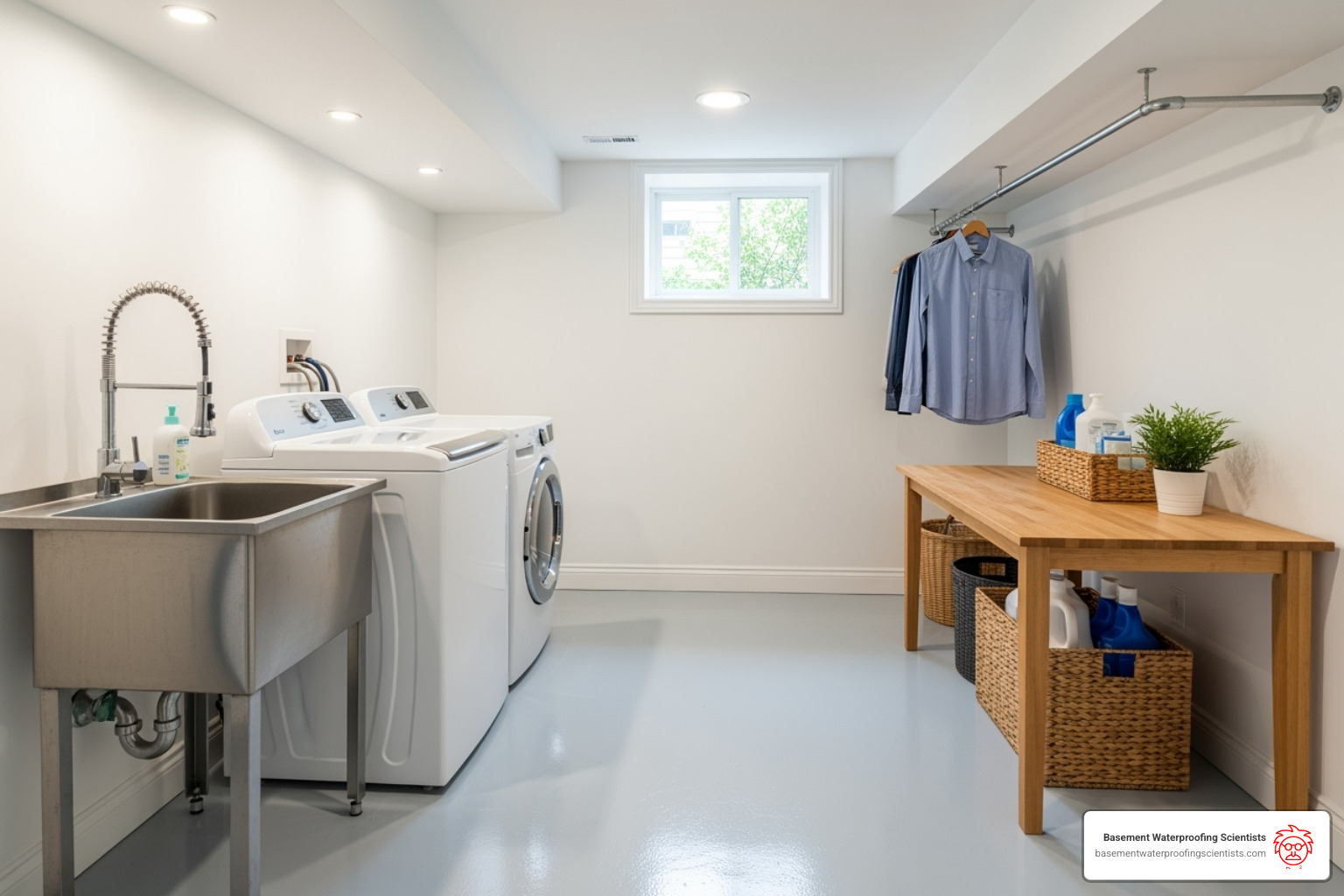
The bottom line is that painting your basement floor combines immediate visual improvement with long-term practical protection, delivering on both form and function.
A Guide to the Best Basement Concrete Floor Paint Types
Choosing the best basement concrete floor paint is easier when you understand the main types available. Each has distinct characteristics, from heavy-duty workhorses to budget-friendly options for lighter use. Let’s break down the main options to help you find the perfect match for your basement.
Epoxy Coatings: The Durability Champion
Epoxy is the superhero of floor coatings. It’s a two-part system (resin and hardener) that creates a chemical reaction, bonding directly with the concrete to form an incredibly tough, durable surface. Instead of just sitting on top, it becomes part of the floor.
Epoxy resists abrasions, chemicals, and moisture exceptionally well. This moisture-resistant quality is valuable in basements where humidity is a concern. A properly applied epoxy floor can last 10 to 20 years. While the upfront cost is higher at $3 to $7 per square foot, its longevity offers great long-term value.
Epoxy is ideal for high-traffic areas, workshops, and home gyms where you need industrial-grade protection.
More info about epoxy floor coatings
Acrylic and Latex Concrete Paints: The Budget-Friendly Makeover
For a budget-friendly makeover, acrylic and latex concrete paints are an excellent choice. These water-based formulas are approachable and popular with DIY enthusiasts.
Their biggest selling point is easy application. Cleanup is simple with just soap and water. Many low VOC options are available, which means fewer fumes. The trade-off is longevity; these paints typically last 2 to 5 years before needing a refresh. At $1 to $3 per square foot, they are affordable upfront but require more frequent repainting.
These paints work well for low-traffic areas like storage or laundry rooms and come in a wide color selection.
Polyurethane Coatings: The Flexible and UV-Resistant Topcoat
Polyurethane coatings offer excellent scratch and chemical resistance, but their key feature is flexibility. Polyurethane is more flexible than epoxy, allowing it to move slightly with temperature changes, making it less prone to cracking.
Its UV stability is another advantage, as it won’t yellow over time. Polyurethane is often used as a protective topcoat over epoxy systems, combining the durability of epoxy with the flexibility and UV protection of polyurethane. It’s available in both satin and gloss finishes.
When selecting the best basement concrete floor paint, consider your area’s use, your budget, and your comfort level with a DIY project.
How to Choose the Right Paint for Your Basement’s Needs
Choosing the best basement concrete floor paint requires matching the product to your basement’s specific use, your lifestyle, and your budget. Finding the right balance between need, cost, and long-term satisfaction is key.
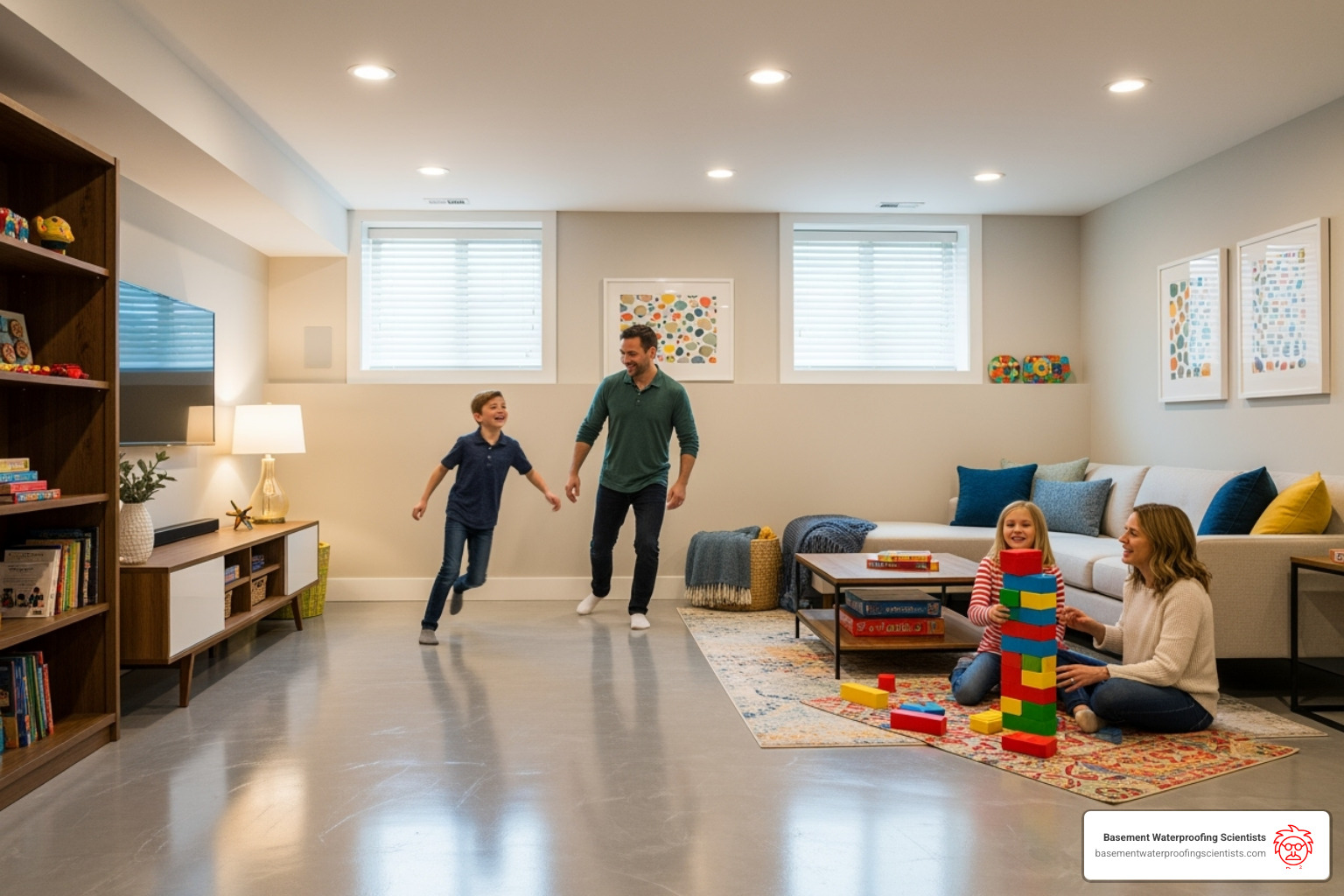
How to select the best basement concrete floor paint for your usage
The intended use of your basement is the most important factor. High-traffic areas like playrooms, home gyms, or workshops need the serious protection of an epoxy coating to withstand impacts and scratches. For low-traffic areas like storage or utility rooms, acrylic or latex concrete paint is a cost-effective solution that still provides a clean, finished look.
When considering your budget, look beyond the initial price. Acrylics cost less upfront ($1–$3/sq ft) than epoxy ($3–$7/sq ft), but epoxy’s 10-20 year lifespan often makes it a better long-term value compared to acrylics, which need refreshing every 2-5 years.
For DIY versus professional application, acrylic and latex paints are very user-friendly. Epoxy requires more precision with mixing and application, so while DIY kits are available, professional installation often yields better results.
Factoring in moisture when choosing the best basement concrete floor paint
Moisture is paint’s biggest enemy and a common issue in basements. It causes paint to fail by bubbling, peeling, and flaking. It’s critical to understand that no paint is a true waterproofing solution. Paint adds a moisture-resistant barrier, but it cannot stop active water intrusion or hydrostatic pressure from below the slab.
If you have water intrusion, musty odors, or visible dampness, these issues must be professionally resolved before painting. At Basement Waterproofing Scientists, we use specialized equipment to identify leak sources and fix them correctly, creating the dry foundation your paint project needs to succeed.
More info about waterproofing your basement floor
Understanding Color and Finish Options
Once you’ve handled the practical considerations, you can focus on aesthetics.
- Colors: Light colors (soft grays, warm whites) make a basement feel bigger and brighter. Dark colors create drama, ideal for a home theater, but can make a space feel smaller. Mid-tone grays are a practical choice for hiding dust and minor imperfections.
- Finishes: High-gloss finishes are sleek and easy to clean but can be slippery and show flaws. Satin or semi-gloss finishes offer a good balance of sheen and durability. Matte finishes provide a non-reflective look but can be harder to clean.
- Safety & Decorative Options: Consider anti-slip additives for any area where moisture is possible. Decorative color flakes or metallic effects can add visual interest and help hide imperfections.
More info about epoxy floor paint colors
The Critical First Step: Preparing Your Concrete for a Flawless Finish
Proper preparation is the most critical step for a long-lasting painted concrete floor. Rushing or skipping this stage is the primary reason for paint failure, leading to peeling and chipping. Before you open a can of your best basement concrete floor paint, prioritize safety by wearing a respirator, gloves, and eye protection, especially when using cleaning solutions or etchers.
The Most Important Test: Checking for Moisture
Moisture is the silent enemy of concrete paint. It can seep up from the ground and ruin a paint job from below, causing bubbling, peeling, and white, powdery salt stains called efflorescence. To check for moisture:
- Tape a 12×12 inch piece of 3-mil plastic sheeting or aluminum foil tightly to the concrete.
- Leave it in place for 24 hours.
- Lift the plastic. If you see any condensation or dampness on the concrete, you have a moisture problem.
If the test reveals moisture, do not paint. The underlying water issue must be resolved first. At Basement Waterproofing Scientists, we specialize in creating permanently dry basements, often with a lifetime guarantee. We use advanced equipment to find and fix leaks efficiently, providing the dry foundation essential for any successful floor coating.
More info about epoxy basement floor waterproofing
Cleaning, Repairing, and Etching the Surface
Once you’ve confirmed the floor is dry, it’s time to prep the surface:
- Cleaning: Remove all dirt, dust, grease, and oil. Use a heavy-duty degreaser for stubborn stains, and a mildew cleaner for any mildew. Rinse thoroughly.
- Repairing: Fill any cracks, holes, or uneven spots with a cement-based patching compound. For cracks wider than ⅛-inch, professional sealing is recommended to prevent moisture and radon gas entry. Allow patches to dry completely.
- Etching: This step is essential for paint adhesion. Etching opens the concrete’s pores, creating a rough texture for the paint to grip. You can use a concrete etching solution or a mechanical grinder. When using an acid etcher, always add acid to water (never the reverse) and ensure good ventilation. After etching, rinse the floor multiple times to neutralize the acid and remove all residue.
- Porosity Test: Sprinkle a few drops of water on the dry, etched floor. If it soaks in, the surface is ready. If it beads up, you need to clean or etch again.
- Final Drying: The floor must be completely dry before painting, which can take several days. Use fans or a dehumidifier to speed up the process.
If you are dealing with a previously painted floor in an older home, be aware of potential lead paint hazards. Follow EPA guidelines on lead dust safety when scraping old paint if you must scrape or sand old paint.
Your Step-by-Step Guide to Applying Basement Floor Paint
With your concrete prepped, it’s time to apply the paint. Proper application is crucial for a smooth, durable finish. Always follow the manufacturer’s directions for your chosen best basement concrete floor paint, as each product has specific requirements for temperature, humidity, and technique.
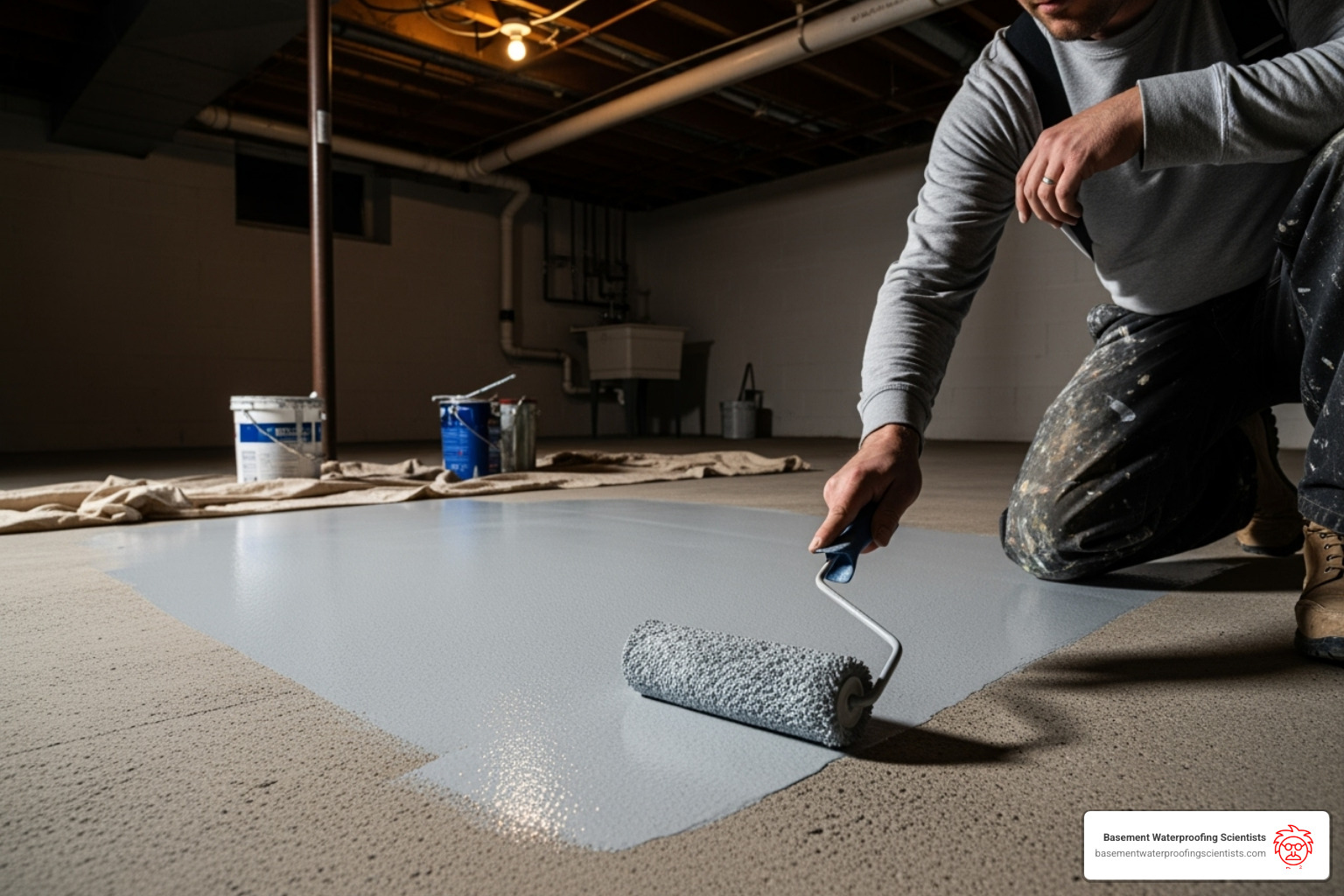
Gathering Your Tools and Supplies
Have all your supplies ready before you begin:
- Stiff-bristled brush
- Shop vacuum
- Degreaser
- Concrete patch and putty knife
- Etching solution and bucket
- Painter’s tape
- High-quality rollers (3/8″ nap)
- Extension pole
- Paint tray
- Paint brush for cutting in
- Personal protective equipment (respirator, gloves, goggles)
The Application Process from Start to Finish
Ensure the air and surface temperature are within the manufacturer’s recommended range (typically 50°F or higher), as cold concrete prevents proper adhesion.
- Prime (if needed): Some paints are self-priming, but a dedicated concrete primer is good insurance for a lasting finish, especially on new concrete. When in doubt, prime.
- Mix Paint: Mix your paint thoroughly. If using multiple cans of the same color, combine them in a larger bucket (a process called “boxing”) to ensure color consistency.
- Cut In: Use a brush to carefully paint the edges along walls and around obstacles. This creates a clean border for rolling.
- Apply First Coat: Pour paint directly onto the floor and spread it with a roller in thin, even coats. Work in manageable sections, maintaining a wet edge by overlapping your strokes to avoid lap marks. Plan your exit so you don’t paint yourself into a corner.
- Dry and Recoat: Allow the first coat to dry according to the manufacturer’s instructions (typically 4-6 hours for latex). Apply a second coat for best results.
- Cure: The floor needs to cure fully before it can handle heavy use. While it may be dry to the touch in 24-72 hours, full curing can take days or even weeks. Avoid placing heavy furniture or rugs on the floor during this time.
- Ventilate: Ensure proper ventilation throughout the process by opening windows and using fans. This is crucial for your safety and for the paint to cure correctly.
More info about applying epoxy paint to a concrete floor
Frequently Asked Questions About the Best Basement Concrete Floor Paint
Here are answers to some of the most common questions we receive about painting basement concrete floors.
How long does basement floor paint last and how do I maintain it?
The lifespan of your painted floor depends on the paint type and traffic.
- Epoxy coatings are highly durable and can last 10 to 20 years with proper care.
- Acrylic and latex paints are less durable and typically need to be reapplied every 2 to 5 years.
To maintain your floor:
- Sweep regularly to remove abrasive dirt and grit.
- Clean spills promptly to prevent staining and damage.
- Use pH-neutral cleaners for mopping; avoid harsh chemicals or abrasive scrubbers.
- Recoat when the paint shows significant wear. For epoxy, a fresh topcoat every 5-10 years can keep it looking new.
Does painting my basement floor waterproof it?
No, painting your basement floor does not truly waterproof it. While a quality coating like epoxy creates a highly water-resistant surface barrier, it cannot stop water from pushing up through the concrete slab due to hydrostatic pressure. Paint is a surface coating, not a deep waterproofing solution.
If your basement has active leaks or dampness, painting over it will only lead to failure. The paint will bubble and peel. The root cause of the water intrusion must be addressed first. At Basement Waterproofing Scientists, we specialize in comprehensive waterproofing solutions. Our services, typically costing between $4K and $8K, create a permanently dry basement backed by a lifetime guarantee. A dry foundation is essential for the best basement concrete floor paint to last.
What are the most common mistakes to avoid when painting a concrete floor?
Avoiding these common mistakes will ensure your project is a success:
- Skipping the Moisture Test: Painting over hidden moisture is the #1 cause of paint failure. Always perform the plastic sheet test first.
- Inadequate Surface Preparation: Failing to properly clean, repair, and etch the concrete will cause poor paint adhesion, leading to premature peeling.
- Using Standard Interior Wall Paint: Wall paint is not designed for floor traffic and will wear away quickly. Only use paints specifically formulated for concrete floors.
- Applying Coats Too Thickly: Thick coats dry unevenly and can lead to bubbling and poor adhesion. Apply thin, even coats as directed.
- Not Allowing for Proper Cure Time: The paint needs to fully cure before it can withstand heavy traffic or furniture. Rushing this step can ruin the finish.
- Poor Ventilation: Good airflow is essential for safety and for the paint to dry and cure correctly.
- Painting Over Spalling Concrete: If your concrete is flaking or crumbling (spalling), the paint will just flake off with it. The underlying concrete issue must be repaired first.
Conclusion: Achieve a Durable and Beautiful Basement Floor
Choosing and applying the best basement concrete floor paint can transform your basement into a bright, functional, and inviting space. We’ve covered the benefits, paint types, selection criteria, and the essential steps of preparation and application.
Key takeaways to remember:
- Preparation is paramount. A clean, dry, and properly etched surface is the foundation for a long-lasting paint job. Never skip the moisture test.
- Match the paint to your needs. Choose a durable epoxy for high-traffic areas or a user-friendly acrylic/latex for lighter use to ensure long-term satisfaction.
- Understand paint’s limitations. Paint adds protection and beauty, but it is not a waterproofing solution. Underlying moisture issues must be fixed first.
With careful planning and by following these steps, you can achieve a durable, beautiful basement floor that adds value and enjoyment to your home for years to come.
For a truly lasting finish, a dry foundation is where it all begins. Here at Basement Waterproofing Scientists, we specialize in ensuring your basement is dry from the ground up by identifying leak sources and fixing them for less. Explore our professional basement floor coatings services to ensure your project’s success from the start.


